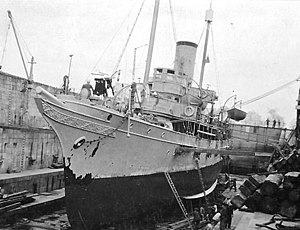USS Vedette (SP-163)

|
|
| History | |
|---|---|
|
|
|
| Name: | USS Vedette (SP-163) |
| Builder: |
|
| Launched: | 23 December 1899 |
| Completed: | 1899 |
| Acquired: | 4 May 1917 |
| Commissioned: | 28 May 1917 |
| Struck: | 4 February 1919 |
| Fate: | Returned to owner 4 February 1919 |
| General characteristics | |
| Type: | yacht |
| Displacement: | 441 tons |
| Length: | 199' 6" |
| Beam: | 26' 0" |
| Draft: | 12' 0" |
| Propulsion: | Steam engine, single-screw |
| Complement: | 61 |
| Armament: |
|
| Armour: | steel-hulled |
The first USS Vedette (SP-163) was a commercial yacht built in 1899. At the outbreak of World War I, the yacht was leased by the United States Navy, and was used as a patrol vessel in the North Atlantic Ocean. She served honorably during the war, rescuing survivors at sea, and attacking a German U-Boat. At war’s end, she was converted to her original configuration and returned to her owner, the railroad executive, financier, and philanthropist Frederick W. Vanderbilt (1856-1938) of New York City.
Virginia - a steel-hulled, single-screw steam yacht designed by G. L. Watson and built at Bath, Maine, by Bath Iron Works for New York City merchant Isaac Stern — was delivered on 23 December 1899. In 1916, the yacht was acquired by the Frederick W. Vanderbilt and renamed Vedette.
The Navy acquired the ship from Vanderbilt on a free-lease basis on 4 May 1917. Earmarked for convoy escort and patrol duty overseas, Vedette was assigned the section patrol number SP-163 and was commissioned at the New York Navy Yard in Brooklyn, New York, on 28 May 1917 with Lieutenant Commander Chester L. Hand in command.
Vedette and five other patrol vessels - all former yachts - got underway from Tompkinsville on Staten Island, New York, bound for Bermuda on 9 June 1917 on the first leg of their voyage to France. USS Sultana (SP-134) and USS Christabel (SP-162) were the first to weigh anchor; USS Harvard (SP-209), USS Kanawha (SP-130), USS Noma (SP-131), and Vedette followed. The ships formed up into divisions, with Vedette leading the second group.
...
Wikipedia
